Whether you have a new or used Takeuchi machine, it’s always important to know the different warning lights symbols that may appear on the dashboard. With this knowledge, you can quickly identify and remedy any issues before they become serious problems. This article will explain the various Takeuchi warning lights that may be found on your machine and what action should be taken when the light is illuminated. We’ll also provide some tips on avoiding these warnings in the future so your device can stay running smoothly.
💥See also: Caterpillar Warning Lights, Symbols and Means
Takeuchi Warning Lights and Color Definitions
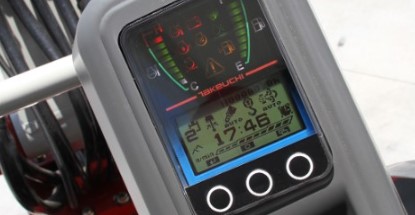
When it comes to operating a Takeuchi excavator, you should be aware of certain warning lights and color definitions. Here is a quick guide to help you understand what each one means:
- Red: A red light on your Takeuchi excavator indicates something is wrong and needs immediate attention. If you see a red light, stop the machine and immediately investigate the issue.
- Orange: An orange light usually signifies a less severe issue that doesn’t require immediate attention but should be checked soon. For example, an orange light may come on if your fuel level is low or a filter needs replacing.
- Yellow: A yellow light is generally used as a warning or caution signal. For example, if your engine oil level is low, you may see a yellow light come on. It’s important to heed these warnings to avoid more severe issues down the road.
- Green: Green lights are typically used for informational purposes only and do not indicate any problem. For example, some Takeuchi excavators have a green light that comes on when the engine start button is pressed.
What do the Takeuchi Warning Lights Symbols mean?
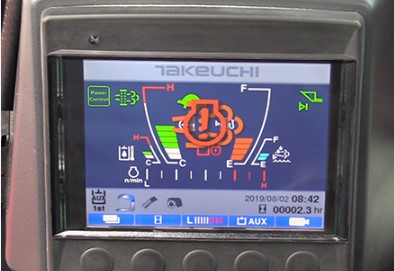
The Takeuchi warning lights symbols are designed to give the operator a quick visual indication of the machine’s status. The following is a list of the most common signs and their meanings:
- Battery Charging: This light indicates that the machine’s battery is being charged.
- Engine Oil Pressure: This light comes on when the engine oil pressure is low. It is essential to check the oil level and add oil if needed.
- Coolant Temperature: This light comes on when the coolant temperature is high. It is essential to stop the machine and let it cool down before continuing the operation.
- Auxiliary Hydraulic Pressure: This light comes on when the additional hydraulic pressure is too high or too low. It is essential to check the hydraulic fluid level and add fluid if needed.
Read also: Mini Cooper Warning Lights and Symbols
Action to take when a Takeuchi warning light appears
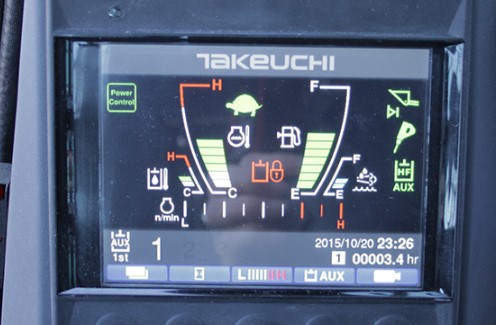
When a Takeuchi warning light appears on your dashboard, it is essential to take action immediately. Depending on the severity of the issue, you may need to stop the machine and contact a technician. Warning lights can indicate many different problems, so it is essential to consult your owner’s manual to determine the best course of action. Some common issues that may trigger a warning light include:
- Low engine oil level
- Coolant level low or coolant temperature high
- Air filter restriction
- Fuel filter restriction
- Hydraulic system overheat
- Auxiliary hydraulics overheat
If you are unsure what the problem is, it is always best to err on caution and stop the machine. Once you have eliminated the device, consult your owner’s manual or contact a Takeuchi dealer or service center for assistance.
How to Respond to Takeuchi Warning Lights Symbols?
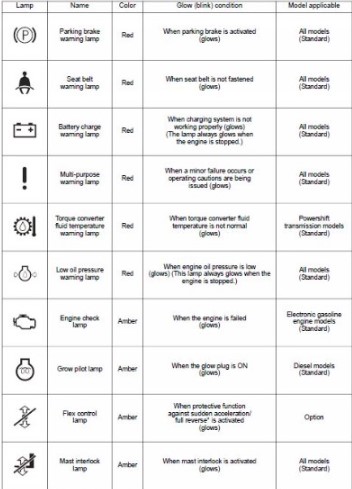
The first step is to identify the warning light symbol. Takeuchi has various warning lights, each with a different meaning. Once you have identified the character, consult the Takeuchi operator’s manual to determine what action needs to be taken.
If the issue is minor, such as a low engine oil level, you may be able to resolve it yourself. However, if the light indicates a more severe problem, such as an overheating engine, it is best to contact a qualified Takeuchi dealer for assistance.
👀Look at this: Isuzu Truck Dashboard Warning Lights Symbols
What Kind of Tractor is Takeuchi?

Different Takeuchi models will have other engine and transmission types. The skid steer loader models generally have a four-cylinder engine, while the track loader models have a six-cylinder engine. The rough terrain forklift models have a three-cylinder engine. All Takeuchi engines are diesel. Most recent model-year machines have an electronic control module (ECM) that monitors various engine functions.
What problems does Takeuchi Have?
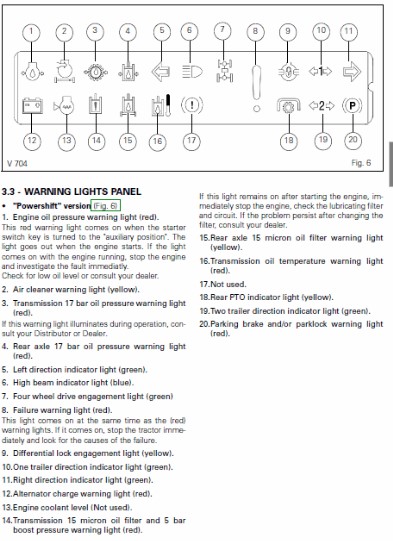
Takeuchi has been having problems with its track loaders. The company has been getting reports of the track loaders losing power and stalling. This has been happening more frequently, and Takeuchi is investigating the cause. In the meantime, Takeuchi advises customers to check the engine oil level and fuel filter before operating the track loader.
Takeuchi warning lights are valuable for ensuring your machine is operating correctly. By understanding the symbols and the implications of each one, you can keep your Takeuchi running efficiently and safely. Remember to refer to your Operator’s Manual when in doubt so that you can make sure you understand what each symbol means and how best to respond. With knowledge, know-how, and maintenance, you’ll enjoy years of problem-free operation from your Takeuchi!
🚨You may be interested in: Honda Pilot Dashboard Warning Lights Symbols
FAQs About Takeuchi Warning Lights Symbols
What do different dashboard warning lights mean?
Drivers should be aware that there are three categories of warning lights; red, amber, and green. Red warning lights indicate the need to stop the car when it is safe. Amber warning lights require action from the driver, and green warning lights provide information only. Drivers need to know what each type of light means to make informed decisions on how they respond when driving a vehicle with these warnings activated.
What does this warning light on the instrument panel mean?
A red warning light on the instrument panel indicates serious car problems or safety issues and should be inspected immediately. If an orange warning light illuminates, it is recommended that the cause of this be checked promptly. The owner’s manual can provide further information about these lights and their meanings.
What do fault lights mean?
A color-coded status indicates the system – green meaning functioning correctly, yellow indicating something not working as it should, and red warning of a severe issue that needs to be addressed immediately. It is necessary to take heed of each indication to ensure that the system operates safely and effectively.
What does indicator light mean?
When an issue occurs in the various areas of a vehicle’s chassis systems, such as ABS brakes, traction control, electronic suspension, and brake hydraulics, an indicator light will activate to alert the driver. This allows individuals to be aware of any potential faults that may have arisen in their vehicle.


I found this article to be very helpful. Knowing the warning lights and what causes them can help me keep my machine running optimally. I appreciate the advice on how to avoid these warnings in the future!